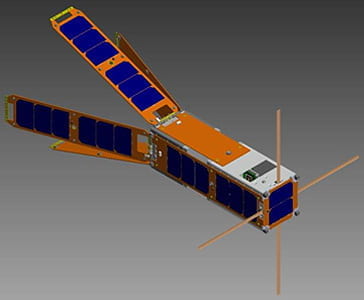ALICE is the first nanosatellite developed by the Air Force Institute of Technology (AFIT), an Air Force graduate engineering school at the Wright Patterson Air Force Base (WPAFB) in Ohio. The primary goal of ALICE is to evaluate a pair of advanced Carbon Nanotube (CNT) arrays as a proposed propulsion system for nanosatellites. The nanotubes in question were developed in partnership with AFIT, Air Force Research Laboratory (AFRL), and the Georgia Tech Research Institute (GTRI).
ALICE is a 3U CubeSat provided by the National Reconnaissance Office (NRO) Colony CubeSat program . The 3U CubeSat is rated at a size of 10 cm x 10 cm x 34 cm and a mass of ~ 5 kg. The bus is a Colony 1 class bus manufactured by Pumpkin Incorporated. The CubeSat is equipped with four deployable solar arrays which run the length of the bus along with body-mounted panels to supply power for the sensor compliment and testing payload.
ALICE was assembled, fabricated, and tested at AFIT by a multi-department team of professors, students, and technicians. The team was comprised of both military personnel and civilians, and included students from many Ohio universities. GTRI and USAFA also provided students in each institution the opportunity to participate in the development of new spacefaring technologies and contribute to the future of electric propulsion.
The ALICE mission is controlled by an independent ground station at AFIT. This effort by AFIT comprises and end-to-end mission plan and is the first of many planned in the coming years.
Launch:
ALICE was contained as a secondary payload on December 6, 2013 aboard an Atlas-5-501 launch vehicle from Vandenberg Air Force Base, CA. The primary payload on this flight was the classified NROL-39reconnaissance mission of the National Reconnaissance Office. The launch provider was the United Launch Alliance.
Sensors and Payload:
Engineers in the Electrical Engineering Department at AFIT developed a unique payload to directly expose the Carbon Nanotube arrays to the space environment while protecting an identical control array within the satellite. The arrays, which are each approximately 1 square cm in size, can be controlled from the AFIT ground station to study their behavior when both active and inactive. The payload experiment utilizes a design from engineers at the U.S. Air Force Academy (USAFA) to measure the number and speed of electrons produced by the CNT arrays. This sensor device is known as iMESA (Integrated Miniaturized Electromagnetic Analyzer) and has a mass of 150 g and a power requirement of 0.5 W.
The carbon nanotube arrays are excellent conductors and their geometry makes them ideal electron emitters. Researchers at the Georgia Tech Research Institute (GTRI) produced the CNT arrays using unique technology that grows bundles of vertically-aligned nanotubes embedded in silicon chips. In future versions of electrically-powered ion thrusters, electrons emitted from the carbon nanotube tips may be used to ionize a gaseous propellant such as xenon. The ionized gas would then be ejected through a nozzle to provide thrust for moving a satellite in space.
The satellite payload is highlighted by a pair of carbon nanotube arrays that will be used to demonstrate carbon nanotubes as electron emitters for future spacecraft propulsion that would use the generated electrons to ionize gaseous propellant for ejection. Each CNT array is about 1 square cm in size and contains as many as 50,000 nanotubes.
Existing ion thrusters rely on thermionic cathodes, which use high temperatures generated by electrical current to produce electrons. These devices require significant amounts of electricity to generate the heat, and must consume a portion of the propellant for their operation.
If the CNT arrays can be used as electron emitters, they would operate at lower temperatures with less power — and without using the limited on-board propellant. That could allow longer mission times for satellites, or reduce the weight of the micropropulsion systems.
Sources and Additional Information:
- https://space.skyrocket.de/doc_sdat/alice.htm
- https://www.n2yo.com/satellite/?s=39467
- https://directory.eoportal.org/web/eoportal/satellite-missions/a/alice
- https://nssdc.gsfc.nasa.gov/nmc/spacecraft/display.action?id=2013-072F
| Acronym | ALICE |
| Full Name | AFIT LEO iMESA CNT Experiment |
| Size | 3U |
| Status | Active |
| Launch Date | December 6th, 2013 |
| NORAD ID | 39467 |
| Downlink Frequency | 460.xxx (MHz) |

